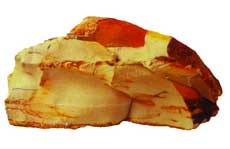
bentonite
Early Americans found bentonite vital to their lives. Pioneers found moistened bentonite to be an ideal lubricant
for squeaky wagon wheels. The mixture was also used as a sealant for log cabin roofing. The Indians found bentonite
useful as a soap.
Small amounts of Wyoming bentonite were first commercially mined and developed in the Rock River area during the 1880s.
Newer, more substantial deposits were discovered in other parts of Wyoming during the 1920s and the first processing plant
in Wyoming was built during this period. Since that time many other processing plants have been built for the purpose of
processing Wyoming sodium bentonite. Wyoming's Bentonite industry produced over 4.0 million tons of bentonite in 1999, with 644
mine and mill employees, and 240 contractor employees.
Wyoming bentonite is composed essentially of montmorillonite clay, also known as hydrous silicate of alumina. In more
simplistic terms, the structure of bentonite is much like a sandwiched deck of cards. When placed in water, these cards
or clay platelets shift apart. Bentonite attracts water to its negative face and magnetically holds the water in place.
because of this unique characteristic, Wyoming bentonite is capable of absorbing 7 to 10 times its own weight in water,
and swelling up to 18 times its dry volume.
Exploration for new bentonite beds is normally accomplished with auger bit drilling. Once the auger drill stem reaches
the soft bentonite it sinks very rapidly, which indicates to the driller that bentonite has been found. The auger
flights are then withdrawn and the "sticky" bentonite is sampled from the flights for quality analysis. Bentonite
is mined by surface "open pit" methods. Various types of heavy equipment including bull dozers and rubber-tired scrapers
are used to remove the shale rock overlying the bentonite.
Topsoil, as well as the underlying material, is carefully removed and stockpiled. These "overburden" materials as
they are called will be placed back and reseeded once the bentonite has been removed. The bentonite which is exposed
during this process can be as little as 1 1/2 feet or as much as 10 feet thick. This is the material which is mined and processed.
Many bentonite manufactures prefer to "field dry" the exposed bentonite prior to hauling it to the processing plants.
This is accomplished by plowing and discing while taking advantage of the low humidity and sunny days to dry the bentonite
prior to its removal. The moisture level prior to "field drying" can exceed 30%. This process will normally extract 15 to 20%
of the moisture from the clay prior to hauling.
Upon arrival at the processing plants, the bentonite is placed into designated stockpiles and carried into the plant with front-end
loaders. The bentonite is then dried in a long cylinder called a rotary dryer where approximately 10 to 15% of the moisture is removed.
Natural gas or coal are used primarily as fuels for drying. The finished product has moisture content of 7 to 10%.
Once delivered from the rotary dryer, the bentonite is processed into either a fine powder or granulated into a small
particle or flake. Packaging of the product is the last process to be undertaken. Granular bentonite is a major constituent
of "scoopable" cat litter. Bentonite can be packaged in 50 lb., 100 lb. or up to 4,000 lb. super sacks. After the packaging process
takes place, the bentonite is shipped either by truck or rail to the consumer. Another form of packaging is to ship direct in bulk
pneumatic trucks or rail cars to the consumer.
Bentonite serves as an economical bonding material in the molding processes associated with the metal casting industry. Bentonite, when mixed with foundry molding sands, forms a pliable bond with the sand granules. Impressions are formed into the face of the bentonite/sand mixtures. Molten metal is pored into the impressions at temperatures exceeding 2,800 F. The unique bonding characteristics of bentonite insures the durability of the mold during these high temperatures. Once the process is complete, the bentonite/sand mold can then be broken away from the casting face and reused.
|
